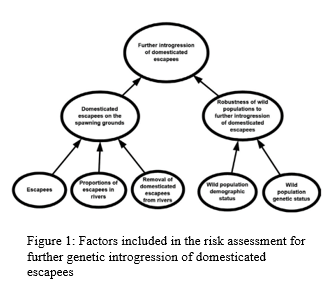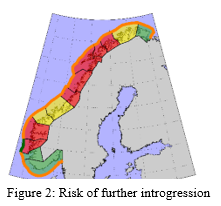RISK OF GENETIC INTROGRESSION OF DOMESTICATED SALMON INTO WILD ATLANTIC SALMON POPULATIONS
The Norwegian r isk assessment of aquaculture uses Bayesian network structures for visualizing risk, including risk of further genetic introgression of domesticated salmon escapees in wild populations. E very year thousands of farmed Atlantic salmon (Salmo salar L ). enters the wild environment, and thus far introgression have been documented in two thirds of the populations investigated. Here we present the results of the 2022 risk assessment executed across 13 large-scale production areas , and the ongoing work towards executing risk assessment at a higher resolution: geographical dispersal of escapees, river s-specific attractiveness of escapees and population-specific vulnerability towards introgression.
There are five factors included in the current risk assessment for further introgression of domesticated escapees . Together these factors represent the numbers and proportions of domesticated escapees in spawning populations and the resilience of the wild population ; (1) the number of escaped fish reported to the authorities; (2) the observed proportions of escapees in a river as reported by the national monitoring program; (3) the removal of farmed escapees pre-spawning; (4) the demographic status of the wild populations (spawning target status) and (5) the genetic status (level of introgression) of the wild
populations.
Aquaculture production is regulated through 13 production areas. The 2022 risk assessment shows that only the two southernmost
(production area 1 and 2), as well as the northeastern production area (area 13) are considered to have a low risk of further genetic change (further introgression ) as a result of escaped farmed
salmon. Three of the other production areas (5, 6 and 12) are
considered to have a moderate risk of further genetic change, while seven production areas (3, 4 and 7–11) are considered to have a high risk of further genetic change as a result of escaped salmon.

